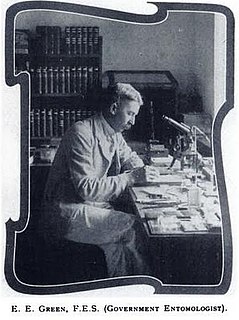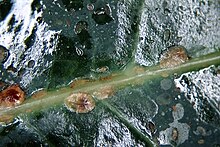Asterolecanium coffeae or yellow fringed scale is a pit scale insect pest on coffee plants, especially Coffea arabica, throughout tropical Africa, including Angola, the Democratic Republic of Congo, Kenya, Uganda and Tanzania. In addition to coffee plants it feeds on jacaranda and Photinia japonica.

Kermes is a genus of scale insects in the order Hemiptera. They feed on the sap of evergreen oaks; the females produce a red dye, also called "kermes", that is the source of natural crimson. The word "kermes" is derived from Persian or Turkish qirmiz or kirmizi, "crimson".

The Margarodidae or ground pearls are a family of scale insects within the superfamily Coccoidea. Members of the family include the Polish cochineal and Armenian cochineal and the original ground pearl genus, Margarodes. Beginning in 1880, a number of distinct subfamilies were recognized, with the giant coccids being the first. Although Maskell proposed a new family, many continued to regard the monophlebids as a mere subfamily for many years, and the Margarodidae classification continued to be polyphyletic through the 20th Century. Since then, taking the advice of Koteja several subfamilies and tribes have been elevated into their own families such as Matsucoccidae and Xylococcidae. The pared-down family of Margarodidae is monophyletic.

Aspidiotus is a genus of armoured scale insects. It includes several agricultural and horticultural pests.
Paratachardina pseudolobata, the lobate lac scale, is a polyphagous and pestiferous lac scale insect, which damages trees and woody shrubs in Cuba, Florida, the Bahamas and the Australian territory of Christmas Island. It was mistakenly identified as Paratachardina lobata (Chamberlin), an insect native to India and Sri Lanka, but was in 2007 recognized and named as a distinct species based on material from Florida; its native distribution is as yet unknown. The new lac insect was described based on all stages of the female, during the revision of the genus Paratachardina, wherein all its known species were redescribed.

Edward Ernest Green was an Ceylon-born English mycologist and entomologist who specialised in the scale-insects, Coccidae. An accomplished artist, and lithographer, he illustrated the five volume Coccidae of Ceylon.

The Coccidae are a family of scale insects belonging to the superfamily Coccoidea. They are commonly known as soft scales, wax scales or tortoise scales. The females are flat with elongated oval bodies and a smooth integument which may be covered with wax. In some genera they possess legs but in others, they do not, and the antennae may be shortened or missing. The males may be winged or wingless.
Kuwanaspis is a genus of scale insects belonging to the family Diaspididae. They feed on bamboo.
Conchaspis capensis is a species of scale insect from South Africa found on Metalasia muricata and Phylica species. It was originally described by Carl Linnaeus in his 1763 work Centuria Insectorum.
Conchaspididae is a small family of scale insects known as false armoured scales because of their resemblance to Diaspididae.

Pulvinaria is a scale insect genus in the family Coccidae. The type species is Coccus vitis Linnaeus.
In the 10th edition of Systema Naturae, Carl Linnaeus classified the arthropods, including insects, arachnids and crustaceans, among his class "Insecta". True bugs and thrips were brought together under the name Hemiptera.

Coccus viridis is a soft scale insect in the family Coccidae with a wide host range. It is commonly known as green scale or sometimes coffee green scale because it is a major pest of coffee crops throughout the world.
Putoidae is a family of scale insects commonly known as giant mealybugs or putoids. There is probably a single genus, Puto, containing about sixty species. The genus name Macrocerococcus has also been used but it is now considered to be a synonym of Puto. The genus Puto was formerly classified as a member of the Pseudococcidae; however, it so significantly differed from the rest of the Pseudococcidae that it was accorded its own family Putoidae.

Aulacaspis, is a scale insect genus in the family Diaspididae. The type species is Aulacaspis rosae.

Dactylopius is a genus of insect in the superfamily Coccoidea, the scale insects. It is the only genus in the family Dactylopiidae. These insects are known commonly as cochineals, a name that also specifically refers to the best-known species, the cochineal. The cochineal is an insect of economic and historical importance as a main source of the red dye carmine. It has reportedly been used for this purpose in the Americas since the 10th century. Genus Dactylopius is also important because several species have been used as agents of biological pest control, and because several are known as invasive species.
Coccus longulus, the long brown scale, is a species of soft scale insect in the family Coccidae. It is found in Europe.

Physokermes are a genus of scale insects known as the bud scales. They are restricted to the Holarctic, though Physokermes hemicryphus has been introduced to North America. Some species are plant pests.
Trabutina mannipara, or mana scale, is a species of mealybug found in the Middle East and southern Europe. It is the most well-known of the five species in the genus Trabutina, of which it is the type species, due to its association with the biblical story of manna. T. mannipara feeds parasitically on tamarisk trees, and excretes a sweet substance which is sometimes collected for human consumption. Obsolete terms for it include Coccus manniparus and Trabutina palestina. This species can be found in the Sinai and Iraq.
Ferrisia is a genus of mealybugs.









